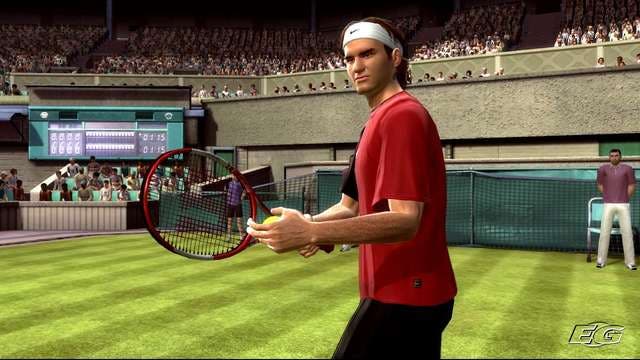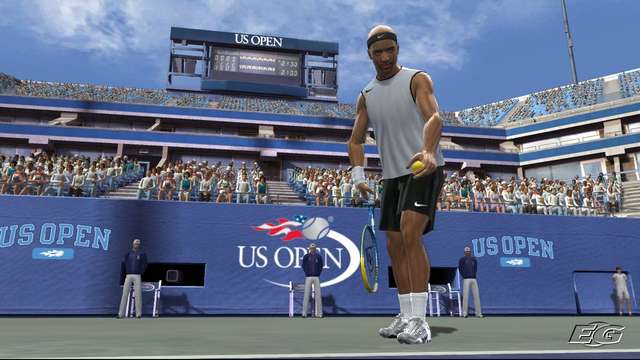Top Spin 2
£50? Out!
It's pretty tough to cock-up a tennis videogame. For a start, all the action takes place on a single screen, and there are a maximum of four players to animate, and the rules are about as straightforward as any sport in existence. So long as the animation's good, the ball physics are believable and the controls feel right there's not much else a developer has to worry about. Maybe some licensing, venue and sponsor fluff to make the package feel official, but that's really all there is to it.
The fact that Virtua Tennis nailed all of this about six years ago didn't really leave much room for Top Spin's arrival back in 2003, so it had to fill in the blanks and provide online play for the first time, full player customisation and a control system that traded risk for reward. It was good, and the fleshed-out career mode made it feel less of a rival and more of a companion. VT2 was still the king, with its superior graphics and more instinctive feel, but no tennis fan dismissed TS the way your average PES fan routinely sneers at FIFA without even giving it a chance.
The inevitable sequel doesn't exactly progress far beyond what the original did, but, like we said, it's pretty tough to cock up a tennis videogame, and PAM manages to tick all the right boxes with a very solid if unspectacular offering that no tennis fan in possession of a 360 will want to miss out on.
Under control
Once again, the key differentiator between Top Spin 2 and Hitmaker's astounding, all-time classic is focused on the controls. Whereas VT keeps things incredibly simple, Top Spin 2 believes in giving the player more options, which is something of a double-edged sword.
On a basic level, there are four shot types to choose from that correspond to the face buttons and the direction you hold the left stick. The easiest but least effective is the safe swing, which is a shot or serve that will never go out but rarely wins you points either. Beyond that, there's the exceptionally useful (but risky) topspin shot which flies fast and high and outwits even the most skilful opponent when you weight it perfectly; the lob, which helps neuter the net-huggers; and the slice, which is a low, fast shot. In addition, applying the left trigger to any of the shots grants you a slight variation on each of these shots - but requires a chunk of your 'momentum' bar. Momentum comes from winning shots, so when you're on a roll you've got the added bonus of being able to unleash even more effective shots into the bargain. Losing points, though, reduces your momentum while fuelling your opponent's bar, turning matches into something of a tug-of-war.
If you're feeling really brave, there are a further four 'risk' shots available to you if you hold down the right trigger before taking your swing. The issue here, though, is that you have to time your shot just as the rising power bar approaches maximum, or else you'll fluff it completely and end up losing the point - not to mention your momentum - via an unforced error. Much like the original Top Spin, you'll most likely only resort to risk shots when you really have to, as the chances of pulling them off are relatively small. By far the best tactic seems to be to reserve them for pulling off ace serves - given that you've always got a second serve if it doesn't work out.
Button down

The inherent strategic differences in control make Top Spin 2 less accessible in many ways, because there's never the same sense of having quite the full command over the angle and power as you do in VT's far more stripped-down system. Of course, you quickly learn to adapt, but there's still a lingering sense of frustration that the more advanced shots are just harder to pull off for the sake of it rather than adding more depth. It's not as though it makes the game more fun; it just adds a slightly needless layer of complexity to what is, after all, a remarkably simple game. That said, you'll still play Top Spin 2 metronomically for hours on end, and it is a huge amount of fun regardless of the differences that may irk you if you're schooled on VT's principles.
One of the main reasons that Top Spin 2 is so feverishly compelling is the career mode, which could feasibly lock you into playing it on your lonesome for weeks on end as you vie for the top spot. Kicking off with yet another GameFace-style system (similar to Oblivion, with a remarkable degree of potential), you create your male or female tennis star-in-the making, choose three 'natural' abilities from the list of main stats and go about climbing the career ladder from 200 right to the top.
At first you'll engage in some typical training mini-games - the sort that VT fans have come to know and love over the years, albeit with a bit more of a serious slant. For example, service training involves hitting specific zones (rather than, say, trying to maker the perfect burger) or boxes, while other training sessions hone your power by focusing on knocking down walls, lines of dominos, or a giant bowling ball surrounded by boxes. Unlike the VT training, each level you complete changes the task at hand quite dramatically, so it's not just a case of learning the same task and having to do more of it. However, just like VT, the net result of success (of failure) is a small increase to your various stats, such as serve, volley, power, reflexes, stamina and so on. Over time you'll build your tennis rookie into a challenger, but not through training alone.
Racketeering

Because training costs money, you'll find that you have to enter regional competitions and the like to boost your coffers, not to mention increase your year-on-year ranking and overall world ranking. As you do that, your sponsor (all the big names are here) will reward you for meeting certain conditions, and rival coaches start to approach you, offering expertise in areas of training that the default one may not.
Usefully, you can choose to simulate entire competitions if you don't want to play in them yourself, or simulate parts of a match and intervene if it looks like you're about to lose. It's a risky business, but it does at least save you a bit of time once you've improved a little - and helps get the money in to get back to the all-important business of training yourself up.
On the whole, the matches feel pretty well balanced, and although they're never exactly a massive challenge, there's a certain degree of satisfaction gained by chipping your way through the game and gradually working your way to the upper echelons.
If that sounds like too much of a grind, the game does offer all 24 main male and female players from the start, including some of the world's best-known players (Roger Federer, Andy Roddick, Tim Henman and Carlos Moya on the male side and Lindsay Davenport, Maria Sharapova and Venus Williams from the lady's camp, for example), so you can jump straight into top level Exhibitions or Tournaments if that's more your thing, giving you the chance to check out the subtle differences between the surfaces and venues. Sliding around on clay feels a whole lot different to how you might remember it from other games, and is one area Top Spin 2 excels at replicating in a convincing fashion.
Slam drunk

The online play is disappointingly bereft of fleshed-out ideas and options, though, with ranked matches restricted to your Grand Slam mode custom creation. On one hand this at least gives you more of an incentive to play the game's offline career mode, but on the other creates a potential imbalance. That said, playing unranked matches give you the full selection of licensed players, so it's not a massive issue.
Setting up quick or custom matches follows the usual level of Xbox Live slickness, and no one will have any issues there, but some dodgy lag did creep into every match we played at some point or other. It didn't affect the game to a serious degree, but little split-second pauses spoilt the flow enough. Whether this is representative of real-world performance is unknown (though it's important to stress we were joining the real servers using a final boxed copy). For lag issue to creep in when the service was virtually empty is a bit of a concern, and one we hope will be addressed. The glitches weren't confined to online play, though, with one career match taking place against an invisible opponent!
On a technical level, Top Spin 2 is pretty solid, without ever coming close to stretching the Xbox 360 in any meaningful way beyond being in high definition. The graphics are nicely detailed and well animated, but not significantly more than the original, and in some senses the general flow of the game still lags behind Sega/Hitmaker's efforts. For example, on many, many occasions, you'll miss shots for completely inexplicable reasons, even when your player is within seemingly easy reach of the ball. It's hard to put a finger on why the controls don't seem to quite respond as you'd like, but the truth is there's definitely something amiss. Players don't stretch out as instinctively as they do in VT, and as a result you'll lose points in situations where you should have just about clawed them back. On a simple level, it's as though they can't be bothered. Sometimes the players just aren't responsive - and therefore not believable enough.
Tie breaker

One thing that is good, though, is the level of detail lavished upon the stadium environments, right from the local park club, moving up to poolside courts with choppers taking off in the distance, right up to the major well-known venues from the Grand Slam circuit. For the first time (probably ever), a tennis title actually gets the crowd and stadiums right (complete with umpires that read out the scores in the native language), and as small a point as it may be in the bigger picture, it's nice they made the effort. With that in mind, it's also a pain that Take Two made zero effort in the music department, with the same generic tunes driving you nuts, hour after hour. Stop!
As incremental an update as Top Spin 2 so evidently is, and as many minor niggles as it has, it still ranks as a fine game in its own right, but one that still - in many respects that matter - lags behind its five-year-old rival in terms of raw playability and fluidity. What it lacks, though, it makes up for with a hugely addictive career mode and the crucial presence of online play. Its fifty quid price tag at launch, though, is an absolute scandal, especially considering that US consumers are getting it at a much-reduced rate (of around $40). While online discounts might net it for £40 or so, which is a bit more reasonable, 2K Games' standard retail price is £50, and European consumers should stand up to this nonsense and vote with their wallets until it's accepted that a game like this isn't worth the same as something like Oblivion and the price is brought down.
Ultimately, Top Spin 2 is a fine tennis title and a game you'll have a lot of fun with off or online, but one that does little to justify its price tag, and is little more than a high def update of the original.








